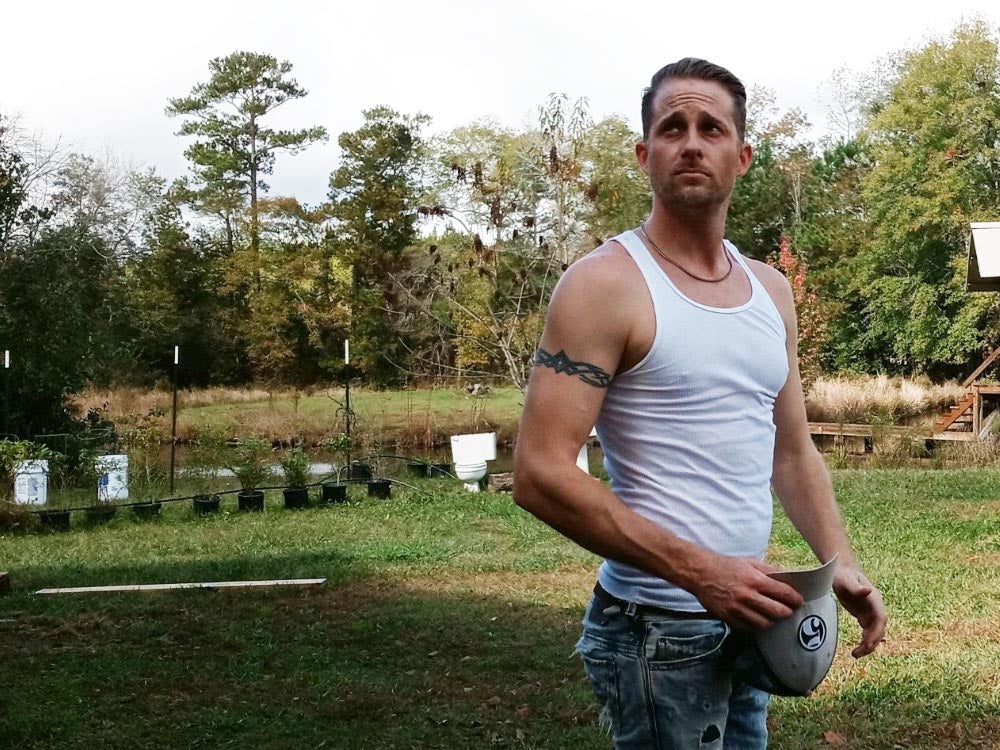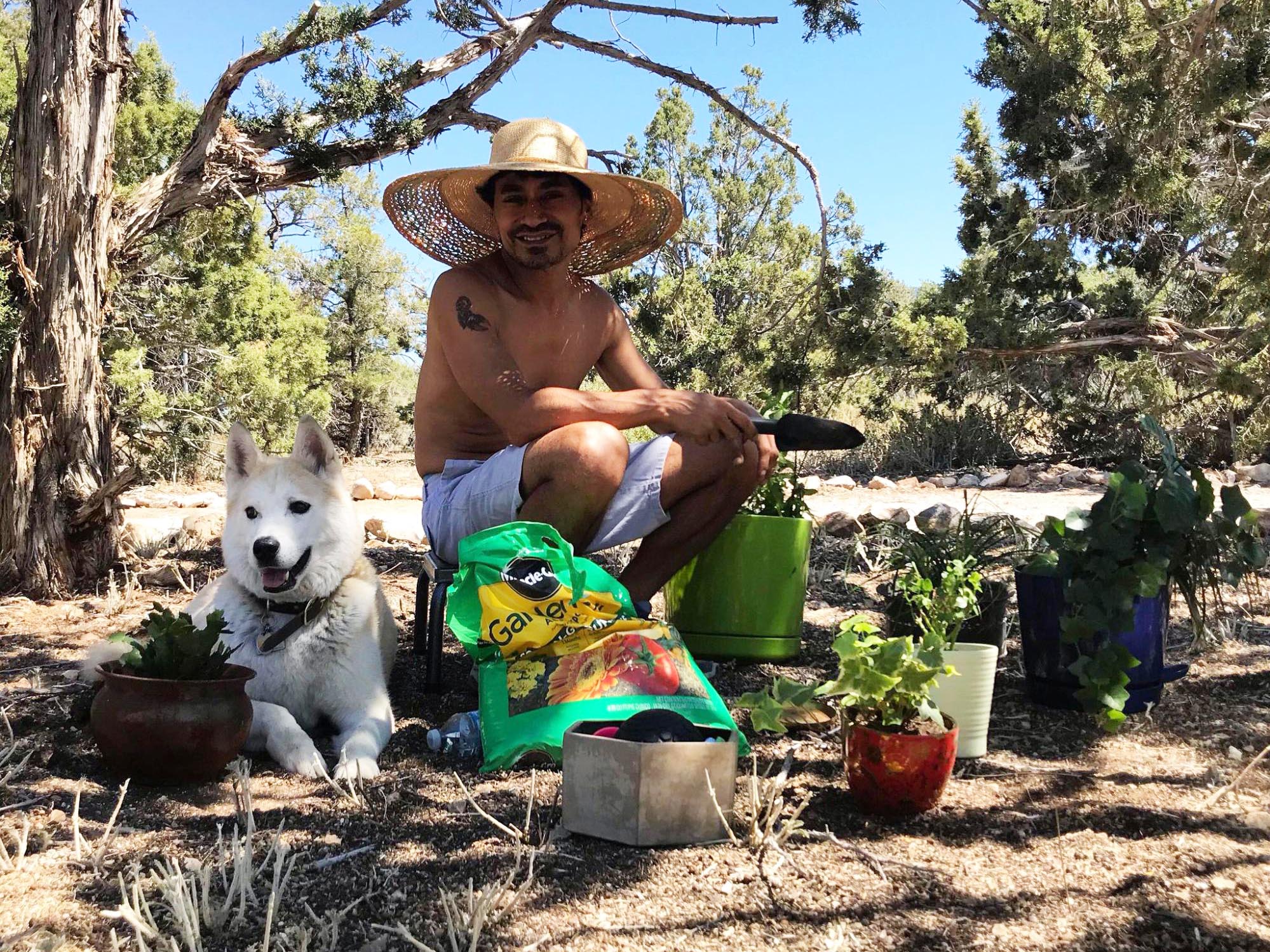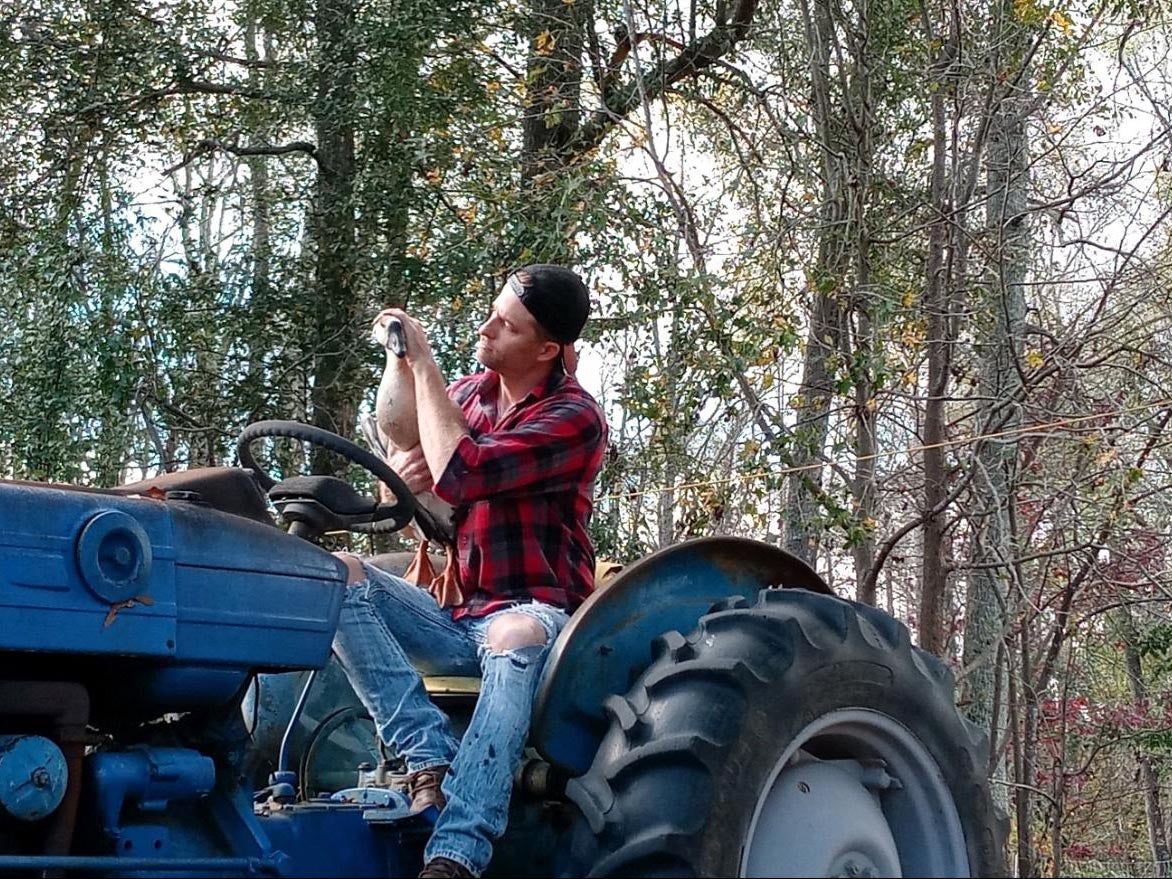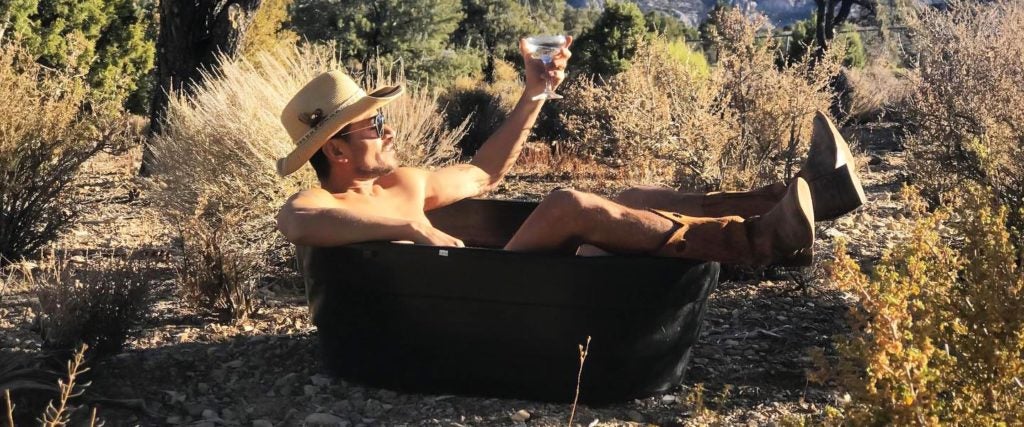Justin Gagliardi calls himself a “lazy farmer,” and compared to most who make their living off the land, he has a point. He spent the majority of his adult life in cities like New York, L.A., Austin and Las Vegas. But in 2018, the 35-year-old gay Army veteran purchased a nine-acre organic farm in the tiny town of Thomson, Georgia, for $180,000, using his disability income of $3,100 per month to pay the mortgage. His official diagnosis is “major depressive disorder with acute anxiety and agoraphobia, and post-traumatic stress stemming from military sexual trauma,” after being raped by another serviceman in 2002. Following years of coping with the disability via crystal meth, he’s now clean and credits life on the farm for his recovery, which offers him purpose and serenity.
Every morning, Gagliardi wakes up around 8 a.m and feeds his dogs — two Miniature Pinschers and two Great Pyrenees — before moving on to seven goats, seven pigs, 150 chickens, guineas and ducks, and a rescue squirrel named Karl. If pens require cleaning, he hoses them down and changes them out, usually finishing all of his chores by three in the afternoon, when he retires to the couch to watch Netflix with his pups.

Gagliardi is among a growing cadre of LGBTQ+ city dwellers who have recently relocated to rural enclaves. Dean H. Jordan, a 52-year-old corporate real-estate recruiter, moved from Atlanta to Carrollton, Georgia, a town with barely 25,000 people on the border of Alabama and the hometown of the man he married. Fortunately, he says, his job regularly brings him to Atlanta, so he enjoys some of the benefits of urbanity without living there. “The sad corollary to this is the dying breed of the gayborhood and chance of meeting people at the bar,” Jordan tells me. He’s happy, but he has dreams about neighbors coming after him and his husband: “Georgia has enough malevolence that I’m not sure you’re fully safe anywhere.”
Rural America has always included LGBTQ+ people, of course — between 2.9 million and 3.8 million as of 2019, according to a study from the Movement Advancement Project (MAP), an independent think tank providing research and analysis to help hasten equality for queer people in the U.S. This equates to five percent of the rural population and 20 percent of the LGBTQ+ population, explains Logan S. Casey, policy researcher at MAP and author of the report. Non-city queer bastions aren’t particularly new either. The Radical Faerie and lesbian land movements of the 1970s were non-big-city LGBTQ+ utopias that have lived in the queer imagination for decades. The same for traditionally rural gayborhoods like, to name just a few, Provincetown and Northampton, Massachusetts; Wilton Manors, Florida; Palm Springs, California; Asbury Park, New Jersey; and Bloomington, Indiana.
In other words, rural gay life has been around for a long time. So too, though, has the concept of metronormativity, the long-held belief that queerdom and urbanity are inextricably linked — lending itself to upward mobility and whiteness — parroted by the media and the likes of Dan Savage. “The reality is that it’s better [for queer people] in places like Seattle and Chicago and San Francisco and New York — even Detroit and Cleveland and St. Louis, I would argue — than it is in some bullshit nothing town in the middle of nowhere,” he explained to The Urbanist in 2017. “There’s more to eat. There are more people to have sex with. There are more opportunities to meet different kinds of people, whether you’re going to fuck them or not.”
But metronormative assumptions are now showing cracks in the face of the pandemic, shedding light on how unaffordable gay meccas like San Francisco and New York truly are.
Because the U.S. census and most federal surveys don’t ask about LGBTQ+ identities, little data is available to study queer migration and confirm the apparent trend of gay city mouses scattering to the countryside, and some balk at the contention. “I certainly wouldn’t call it a trend,” Baker Rogers, an assistant Professor of Sociology at Georgia Southern University, counters. “A lot of my work is about people choosing to stay in rural areas, which I think is happening more than it used to. But I haven’t seen a big mass of LGBTQ+ people moving from cities to rural areas.”
A more common migratory path may be queer people who grew up in the sticks reverting to rural life after stints in the city. Thirty-two-year-old Harold Kuhn certainly fits this bill. He’s originally from West Virginia, spent 12 years in Brooklyn working in fashion and then moved this summer to a farm in Mariposa, California, a town of 2,000 people in the gateway to Yosemite National Park. Now a full-time candlemaker, Kuhn recently developed custom scents for two hotels in Ojai, California, and sells his products nationwide. After spending his childhood “in the middle of nowhere” West Virginia — which he calls the “forgotten state” — ranch life has been pleasantly reminiscent of his childhood helping his father, a logger, split firewood with chainsaws in the woods. “I’m resourceful when it comes to those kinds of things on the ranch, because that’s how I grew up,” he explains.
But he was also gay bashed at his junior prom, so the poor, white town he grew up in left him skeptical and resentful of rurality. Today, though, it’s a different story, as he’s been able to experience nature on his terms. “I wake up early and hang out with yaks, mini pigs and donkeys,” he tells me, having just returned from bass fishing in the middle of the ranch’s lake. “I barely drink anymore, and went vegan. I got too comfortable with the Brooklyn gay lifestyle, getting drunk at the same two bars every night and eating greasy food from a bodega the next morning to cut the hangover. That wasn’t serving me anymore, and I wanted to try something different.”
This aligns with the key finding of a dissertation by Alexis Annes, associate professor of sociology at Ecole d’Ingénieurs de Purpan in France. Annes studied the migratory path of 20 rural gay men — 15 in the American Midwest and 15 in the Southwest of France — most of whom went to the city for a period of time in early adulthood to explore their sexual identity, but all ended up back in the countryside. “For a long time, we considered LGBT migration to be people with rural backgrounds going to the city because LGBT identity construction was impossible in the countryside,” he says. “My research complexified this pattern.”
And yet, it’s not just those born in rural areas seeking refuge there. Forty-five-year-old Giovanni Cassinelli was a “do-or-die New Yorker” who had never lived anywhere other than Queens. But in June, he and his husband, Robert Carr, left NYC behind and moved to Mountain Springs, Nevada, an unincorporated mountaintop town with a fire department, a saloon and roughly 3,000 residents. Carr works remotely as an executive for Shake Shack, making enough to support the couple along with money Cassinelli had saved from his dog-walking business. “I’m not getting my city back, so I decided to leave before it got to the point that I couldn’t get my mind back,” he tells me.
Cassinelli didn’t like the person he was becoming in pandemic-stricken New York. Corpses were regularly being removed from his building in body bags, yet his landlord refused to clean the lobby. A good friend died from COVID, as did his grandmother, yet he’d step outside and encounter a hundred people in 30 minutes not wearing masks. “People just weren’t respecting COVID, and I was losing my mind,” he says, recalling waiting at the post office when an unmasked woman cut in line, which set him off. “I lost it. That’s when I knew I had to get the fuck out of there.”
There was an economic component, too. In northwest Harlem, he and Carr paid $2,500 a month for an apartment on the fourth floor of a building with neither an elevator nor a washer or dryer. Now, they rent two houses on 2.5 acres of land in Mountain Springs for $2,000 a month. “It’s fucking country up here, bro,” he says, explaining that he wakes up around 7 a.m. every morning to add birdseed to feeders and water the basil and mint plants. Next, he tosses scraps out for the wild rabbits hopping about and prunes the pineapple plants and agave trees while waving to elk, deer and wild donkeys making their way to the top of the mountain. The ruralness of it all is ever present, he says, referencing a neighbor’s shoeless kid who recently stopped by to pet his dog. “His dad told me the boy tried wearing shoes at the age of four, but they wouldn’t fit because of the giant calluses he already had on his feet.”
While people definitely look at him and his sartorial choices with curiosity — “I came from fashion, so even my basic rags are ZANEROBE” — he says the assumption that country folk are inherently discriminatory is unwarranted. “When they know you’re from New York City, they roll out the red carpet for you,” he says, recalling a grocery store clerk complimenting his wardrobe and the efficiency with which he and his husband shopped. “She was like, ‘You guys did self-check and you had over a hundred items!’ I told her, ‘We do things ourselves. We’re from New York.’ She looked me up and down, smiled and said, ‘Yeah, I can see that.’ Then she only charged us for four canvas bags when we clearly had 10. That was nice of her.”

One of the goals of MAP’s study was to push back on the widely-held notion that rural areas are homophobic and transphobic, Casey says. The difference, he says, is structural: Because there are fewer employers and health-care providers overall, and farther distances from basic goods and services, when discrimination does occur, it can be more difficult to cope with. “People who come from rural areas want to not have to choose anymore between the place that they called home and getting to be their full self wherever they are,” he explains.
“It’s comforting and encouraging to me to see LGBTQ+ people reclaiming these beautiful, rural outdoor spaces as their homes,” adds journalist Samantha Allen, author of Real Queer America: LGBT Stories From Red States, a biography of her cross-country road trip with pit stops along the way at drag shows, political rallies and hubs of queer life across the heartland.
There’s still plenty of work to do, though, says Aman Emmaus, a 19-year-old transgender man living in Tulsa, Oklahoma, after spending his teen years in L.A. “I can’t wear a Black Trans Lives Matter shirt without feeling like I’m gonna get beat up,” he tells me, explaining that life in Tulsa has contributed to his internalized homophobia and transphobia.
Obviously, the experience of LGBTQ+ people of color who retreat to the country can vary greatly from their white counterparts, explains Jaclyn Wypler, a sociology PhD candidate studying queer and transgender sustainable farmers in conservative rural communities. In particular, she references Mimo Davis, a Black lesbian from New York City who moved to a flower farm in Missouri and has been intimidated by rural “stop-in culture.” “It’s common in rural areas, but feels a lot different when you’re a person of color with a documented history of persecution,” Wypler explains. “All of a sudden, white men with guns were asking all these questions to a Black woman alone in the country.”
As a trans white man, Emmaus thinks he should be able to live and be proud of who he is, but Tulsa has made that extremely difficult for him. “I live in stealth,” he says. “Nobody knows I’m trans here unless I specifically tell them. There are a lot of LGBT+ youth who need to see people like me who have transitioned, to know that life does get better, and that there is life outside of Tulsa, Oklahoma.”
Indeed, rural living, particularly in the Deep South, isn’t for everyone. Bobby McGovern, a 62-year-old gay man who moved with his husband from Southern California to Greenwood, South Carolina to be close to his aging parents, regretted the decision immediately. “People are really nice, like you see in the typical Southern movie with sickening sweetness,” he tells me, but says that’s just on the surface. Within the first five minutes of meeting someone in town, they ask which church he belongs to. Having given up organized religion years ago, he doesn’t have a great answer. And if they find out he’s gay, more often than not, they become stand-offish or downright offensive. “Here in the Deep, Deep South, it’s still one of those things,” he explains, somewhat despondently. “I mean, look at Lindsey Graham. All he has to do is open his mouth and his tits flop out! It goes back to that old Southern thing: As long as you don’t say it, you’re fine. But sometimes you wanna say it!”
Gagliardi, too, says he can feel like an outcast. He’s pretty sure his direct neighbors know he’s gay, but they certainly haven’t discussed it. He removed the Human Rights Campaign sticker from his car, just to be safe. And there was a “gay-bashing” incident, as he calls it, while he was playing pool with his boyfriend at a local bar. They playfully said something sexual to a woman, whose father immediately got in their faces. “I was like, ‘Dude, we’re gay. We’re just playin’,’” he tells me. “Then, of course, he starts calling us faggots and coming at me. Luckily, we didn’t get into a fight, but we had only been in Georgia for two months, so it wasn’t a very nice welcome.”

Mostly then, he focuses on keeping his animals healthy and his farm intact, and tries to steer interactions with neighbors to such ends.
Wypler says LGBTQ+ people like Gagliardi typically learn how to tolerate intolerance. Fewer stores means you become increasingly reliant on neighbors, so you might have to let things slide in order to maintain a longer-term vision. She points to a trans farming couple in Wisconsin she included in a recent paper. “They say, ‘Right now we’re not having a conversation about pronouns with our neighbors,’” she tells me. More than anything, they’re just trying to make sure their neighbors stay in business, because if they don’t, a corporate farm will likely replace them and grow potatoes sprayed with pesticides known to cause brain cancer. “So they might not agree with all of their practices, but it’s a hell of a lot better than it could be.”
Wypler refers to this concept as “land allyship.” Basically, acceptance from both parties emerges around greater evils threatening rural life, like climate change, commodity prices and global trade agreements. “The question becomes,” Wypler continues, “‘How can we support each other in this rural environment with scarce resources to do right by the land and to keep our community vibrant?’”
And yet, that balance is far from easy to maintain. Like when a racist, homophobic neighbor recently came over to help Gagliardi dig holes with his tractor and spoke about getting his shotgun ready just in case “Black Lives Matter n—–rs” tried to come here. Gagliardi bit his tongue, but in his head, he thought, Your shotgun?!?! 7,000 people live here, you really think they’re coming for your farm?!
Finding someone to share rural life with has been difficult as well. He says the pool of closeted guys lurking on Grindr only want to hook up because they’re planning to end up with a woman someday. “It can be really isolating,” Gagliardi says with a sigh, before excusing himself to go feed the pigs and clean up chicken shit. “I have days of depression, but on the whole, everything here is depending on me and that forces me to get up. So I press on.”

